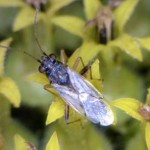Rutherglen bug (Nysius vinitor) is best known as a seed-feeding pest, attacking grain as it develops and fills. However, in some seasons, large numbers of nymphs and adults can cause damage to establishing winter or summer crops. RGB populations can build up in summer weeds, and move from these into establishing winter crop, feeding on and killing small seedlings. Large numbers of RGB moving out of canola stubble poses a threat to nearby establishing summer crop.
| Objectives | Pre-plant – Establishment | Flowering – harvest |
|---|---|---|
| Insects and damage | Seedlings can be damaged by RGB nymphs in seasons where large numbers of nymphs survive in weeds over summer (mild summer with rainfall to promote weed hosts e.g. wireweed/ common knotgrass). Seedlings can be killed by feeding pressure caused by nymphs moving from weeds on field edges. Seed treatment will not protect seedlings against this extreme pressure. Damage is usually confined to field margins. | RGB adults migrate into fields from local weed hosts, or more distant sources in spring. Infestations can be large and the period of invasion prolonged. Adults and nymphs feed on growing tips, buds, flowers, pods/seed causing flower abortion, reduced pod set and seed development. RGB feeding directly on developing seed affects oil quantity/quality and seed viability.
RGB can persist into windrows, and at harvest cause problems with seed flow through harvesters, and by raising the moisture content of the grain to above acceptable standard. |
| Monitor and record | Check the crop from flowering to harvest at weekly intervals. Inspect flower heads visually or shake heads into a bucket. Examine 20 heads at 5-10 locations within the crop.
Distribution is typically patchy across the field which means that the more samples taken, the greater the level of confidence in estimating the size of the infestation. In seasons with wet, mild summer and abundant weed growth, check weeds around the paddock that may be hosting RGB. In particular, Polygonum aviculare (Common Knotweed, Wireweed) is known to be a summer host. Capeweed (Arctotheca calendula) is a common autumn-summer host for RGB
|
|
| Natural enemies |
|
|
| Cultural control |
|
|
| Provisional thresholds |
|
|
| Pesticides |
|
|
| Multi-pest considerations | Control of RGB is highly disruptive to beneficial insects because there are no soft options. Spraying for RGB may have direct impact on Helicoverpa, aphid and DBM populations in the crop; and the beneficials that may contribute to the control of these species. | |
| Communication | Maintain communication with neighbours and local agronomists re influxes of RGB to ensure that these are not overlooked.
Industry publications provide up to date regional information about pest activity in crops. |
|


